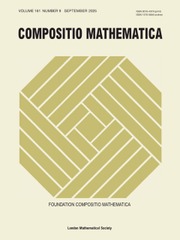Refine search
Actions for selected content:
4515 results for https://joinlive77.com/

Compositio Mathematica
- Published for: the London Mathematical Society
-
- Journal
-
- Get access
- Contains open access
5 - COM–Poisson Regression
-
- Book:
- The Conway–Maxwell–Poisson Distribution
- Published online:
- 02 March 2023
- Print publication:
- 09 March 2023, pp 153-217
-
- Chapter
- Export citation
Appendix 2 - COM Derivation Details
-
- Book:
- Estimation Problems in Hybrid Systems
- Published online:
- 17 August 2009
- Print publication:
- 28 October 1999, pp 251-256
-
- Chapter
- Export citation
7 - The Dot-Com Bubble
- from The Third Era
-
- Book:
- A History of Financial Technology and Regulation
- Published online:
- 24 March 2022
- Print publication:
- 31 March 2022, pp 87-95
-
- Chapter
- Export citation
Chapter 9 - The Dot-Com Bubble
-
- Book:
- Boom and Bust
- Published online:
- 06 August 2020
- Print publication:
- 06 August 2020, pp 152-169
-
- Chapter
- Export citation
6 - COM–Poisson Control Charts
-
- Book:
- The Conway–Maxwell–Poisson Distribution
- Published online:
- 02 March 2023
- Print publication:
- 09 March 2023, pp 218-250
-
- Chapter
- Export citation
Appendix: COM/CORBA Integration
-
- Book:
- Distributed Object Architectures with CORBA
- Published online:
- 07 September 2010
- Print publication:
- 13 February 2000, pp 247-266
-
- Chapter
- Export citation
8 - The British Contract as Com-promise
-
- Book:
- Compromise
- Published online:
- 05 February 2013
- Print publication:
- 11 February 2013, pp 231-265
-
- Chapter
- Export citation
8 - COM–Poisson Cure Rate Models
-
- Book:
- The Conway–Maxwell–Poisson Distribution
- Published online:
- 02 March 2023
- Print publication:
- 09 March 2023, pp 284-311
-
- Chapter
- Export citation
4 - Multivariate Forms of the COM–Poisson Distribution
-
- Book:
- The Conway–Maxwell–Poisson Distribution
- Published online:
- 02 March 2023
- Print publication:
- 09 March 2023, pp 124-152
-
- Chapter
- Export citation
Pedigree of Plumpton, of Plumpton, com. Ebor.
-
- Journal:
- Camden Old Series / Volume 4 / April 1839
- Published online by Cambridge University Press:
- 23 February 2010, p. cxxxix
- Print publication:
- April 1839
-
- Article
- Export citation
O Herói com mil máscaras
-
- Journal:
- Latin American Research Review / Volume 12 / Issue 2 / 1977
- Published online by Cambridge University Press:
- 24 October 2022, pp. 255-261
-
- Article
-
- You have access
- Export citation
Site of Eustachian Tube Obstruction in COM: Presenting Author: Muaaz Tarabichi
-
- Journal:
- The Journal of Laryngology & Otology / Volume 130 / Issue S3 / May 2016
- Published online by Cambridge University Press:
- 03 June 2016, p. S61
- Print publication:
- May 2016
-
- Article
-
- You have access
- HTML
- Export citation
Introduction: New paths, old (com)promises?
-
-
- Book:
- New South African Review 2
- Published by:
- Wits University Press
- Published online:
- 23 March 2018
- Print publication:
- 28 February 2012, pp 1-18
-
- Chapter
- Export citation
Anomalous Pulsation of Field RR Lyrae Variables: Photometric and Spectroscopic Study of CM Leo, BS Com, and CU Com
-
- Journal:
- International Astronomical Union Colloquium / Volume 176 / 2000
- Published online by Cambridge University Press:
- 12 April 2016, pp. 271-272
- Print publication:
- 2000
-
- Article
-
- You have access
- Export citation
Autochthonous livestock in Spain. Ministerio de Medio Ambiente y Medio Rurale y Marino. Published in 2008, pp. 64. Available at http://www.eaap2009.com/Documents/AUTOCHTHONOUS%20LIVESTOCK%20IN%20SPAIN%20(BOOK).pdf
-
- Journal:
- Animal Genetic Resources/Resources génétiques animales/Recursos genéticos animales / Volume 46 / April 2010
- Published online by Cambridge University Press:
- 06 May 2010, p. 90
- Print publication:
- April 2010
-
- Article
- Export citation
2 - The Conway–Maxwell–Poisson (COM–Poisson) Distribution
-
- Book:
- The Conway–Maxwell–Poisson Distribution
- Published online:
- 02 March 2023
- Print publication:
- 09 March 2023, pp 22-70
-
- Chapter
- Export citation
85 - STF 1639 Com = WDS J12244+2535AB
- from 9 - The Catalogue
-
- Book:
- An Anthology of Visual Double Stars
- Published online:
- 17 August 2019
- Print publication:
- 29 August 2019, pp 252-253
-
- Chapter
- Export citation
The comming of Baldwin the Emperour of Constantinople into England, An. 1247
-
- Book:
- The Principal Navigations Voyages Traffiques and Discoveries of the English Nation
- Published online:
- 05 November 2014
- Print publication:
- 17 April 2014, pp 353-353
-
- Chapter
- Export citation
The E-com Strain on Tax Law Concepts
-
- Journal:
- European Business Organization Law Review (EBOR) / Volume 3 / Issue 1 / March 2002
- Published online by Cambridge University Press:
- 17 February 2009, pp. 195-210
- Print publication:
- March 2002
-
- Article
- Export citation
